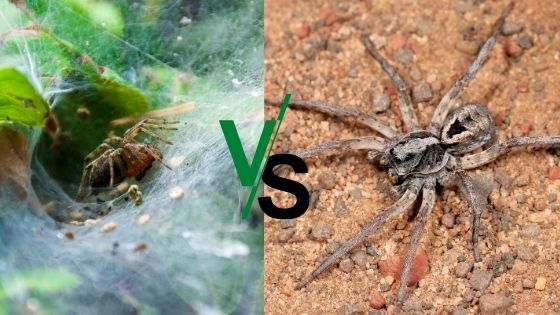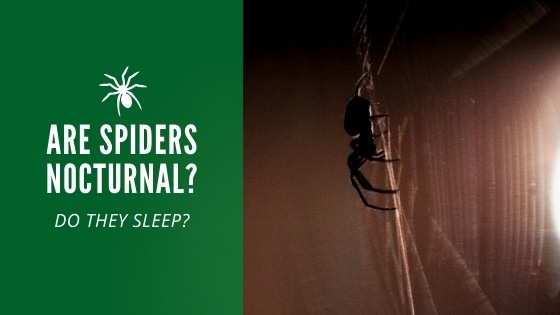Grass Spider vs. Wolf Spider: How to Identify the Difference

Spiders tend to be a houseguest that most people want to get rid of. While they serve their purpose in our ecosystem, they can be a bit creepy to many. Depending on where you live in the U.S. and what time of year it is, there are a few different species of spiders that you’ve probably encountered at one time or another. In the spring and summer, you’ll see a lot of spider activity as they become more active thanks to warmer temperatures.
The fall is also a busy time of year for spiders. They’re preparing for a long cold winter where they won’t be moving around quite so much. Two common spiders in the home or on your property are wolf spiders and grass spiders. They look somewhat similar if you aren’t a spider expert, so many people confuse the two. Do you know what to look for to identify each of these spiders?
How to Identify Wolf Spiders
If it’s fall where you live, and you’re noticing an increase in spider activity, you may be dealing with the wolf spider. They are very active in the fall as they prepare for the cold winter. You’ll frequently find them around exterior doors, windows, in your house plants, around your basement foundation, and in your garage. They don’t spend a lot of time out in the open, but you’ll find them if you start to shuffle things around a bit.
Unlike other spiders that create a web to trap their next meal, wolf spiders will actually roam around in the dark hours of the night to find their meal. Luckily, they’re pretty shy to humans. If you spot one, they’ll probably attempt to get away from you as quickly as they can.
The wolf spider looks a bit like the brown recluse, but they don’t have the unique markings behind their head that the recluse spiders do. Wolf spiders are anywhere from ½ inch long to 2 inches long. They have a long and hairy body that is brown or gray in color. They have various lines or markings that make them unique from one another.
The female wolf spider has a large egg sac that they tote around with them at all times. The newly hatched wolf spiders will ride on their mother’s backs until they’re old enough to venture out on their own.
How to Identify Grass Spiders
Even if you haven’t recently seen a spider on your lawn, you’ve probably seen some small webs that are lying right on top of the grass or some nearby landscaping. It’s easy to mistake the grass spider for another variety but look for the grass spider from spring through summer. They’re approximately 19 mm in length, have four pairs of eyes that are roughly the same size, and they have hind legs that are very distinctive. Look for dark-colored stripes on the sides of their body.
Grass spiders are one of over a thousand species of the Agelenidae family; about 100 of them can be found in North America. These species of spiders are known for their funnel weaving capabilities. Funnel webs are cave-like in shape and are designed to trap prey that may enter by accident.
This funnel web isn’t sticky like other spider webs, but they contain vertical strands of web that entangle their prey. Once the prey has been trapped in the web, the web’s movement alerts the grass spider that they have captured something. The grass spider will then rush into the funnel web and drag the prey to a place where it can be sucked dry of its fluids.
If you’re trying to get rid of grass spiders, make sure that you keep your lawn trim throughout the spring, summer, and fall. This will reduce the amount of comfortable coverage that spiders have. If you notice the webs on the lawn, remove them. Try to keep patios and other areas clean.
Food crumbs will attract a variety of insects that the grass spider will then eat. While you might not think having them outside is a problem, they tend to make their way indoors during the fall in preparation for the long winter ahead. Your warm home is pretty tempting to them. Don’t worry, most of them will die off once the temperatures reach freezing.
Why Are Grass Spiders Mistaken for Wolf Spiders?
Both the grass spider and the wolf spider have stripes on their bodies. While many other spiders have these similar stripes, the wolf spider and grass spider look very much the same if you don’t take a good amount of time to compare them.
Since many of us tend to run away when we spot one of these creep-crawlies, we assume we know what variety we’re dealing with. They both have long, bent, and thin legs that make them appear quite large. They both move quickly, and they both like to hide out in dark and safe spots.
You won’t generally find them in the middle of your home, but rather wolf spiders and grass spiders originate outdoors. They’ll come inside when they feel they need a safer location.
Both the wolf spider and grass spider are also often mistaken for the hobo spider. All 3 of these spiders can be found walking on the ground, but the hobo spider is part of the Agelenidae family, like the grass spider. The hobo spider was once considered to be incredibly venomous, but after some research, they are now considered mostly harmless to humans.
Grass Spider Bites vs Wolf Spider Bites
A wolf spider bite is not poisonous, so you don’t have to worry too much if you find one in your home. However, you can have a reaction to a wolf spider bite if you’re susceptible to reactions from bug bites in general.
Lucky for you, grass spiders don’t usually bite humans. Their fangs aren’t really designed to chomp down through our thick skin. They have a much easier time munching on bugs that they trap in their web, and they’ll probably only bite down on you if they feel threatened. You may have disturbed them.
If one does manage to make a snack out of you for a second, you’re unlikely to have a reaction from them. They’re not poisonous, and they don’t commonly generate an allergic reaction.
While neither of these spiders are extremely dangerous, you probably want to get rid of them if you feel there is a problem that’s getting out of hand. There are some natural repellents that you can use to try and keep them out of your home. Peppermint oil and eucalyptus oil are two scents that will send both grass spiders and wolf spiders running.
You can safely use them around pets and children, so this might be your best option for pest control. If you need help with a spider problem that’s out of control, call in the professionals to make quick work of these unwanted visitors.



